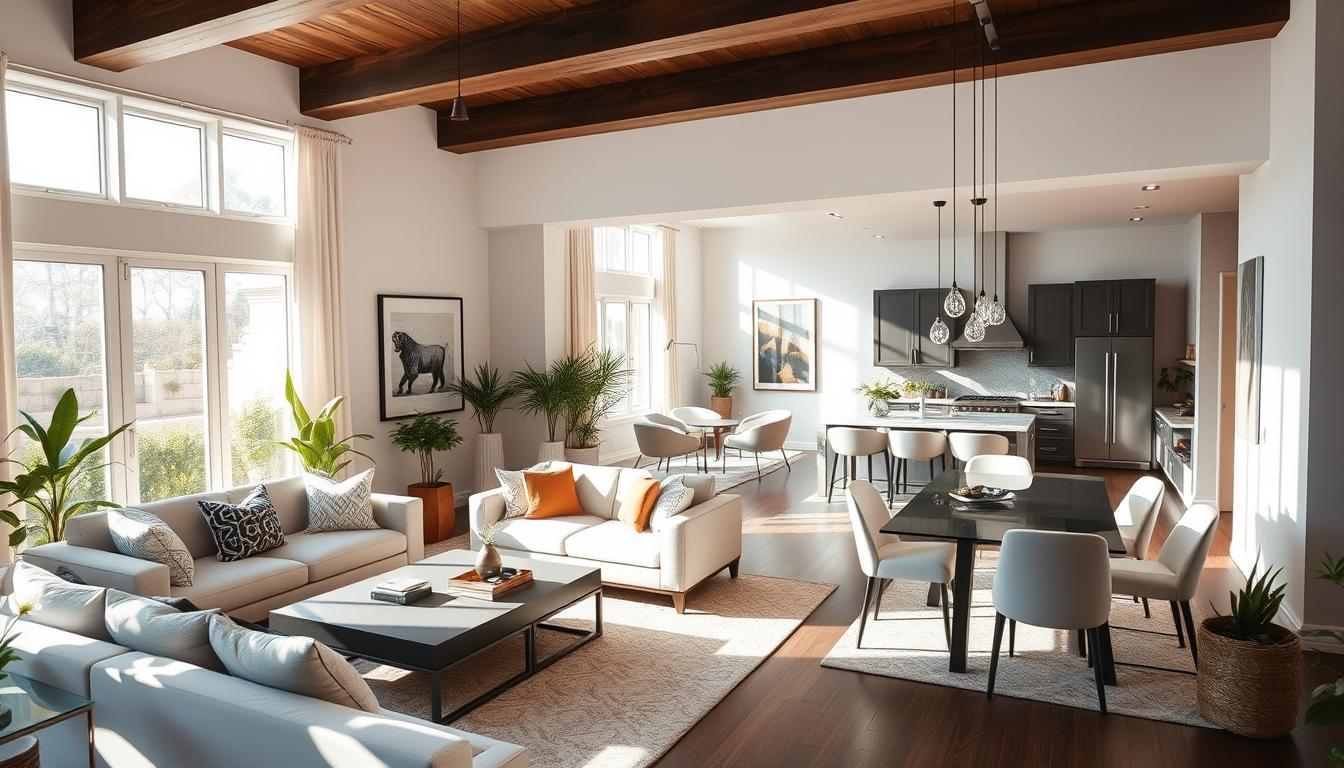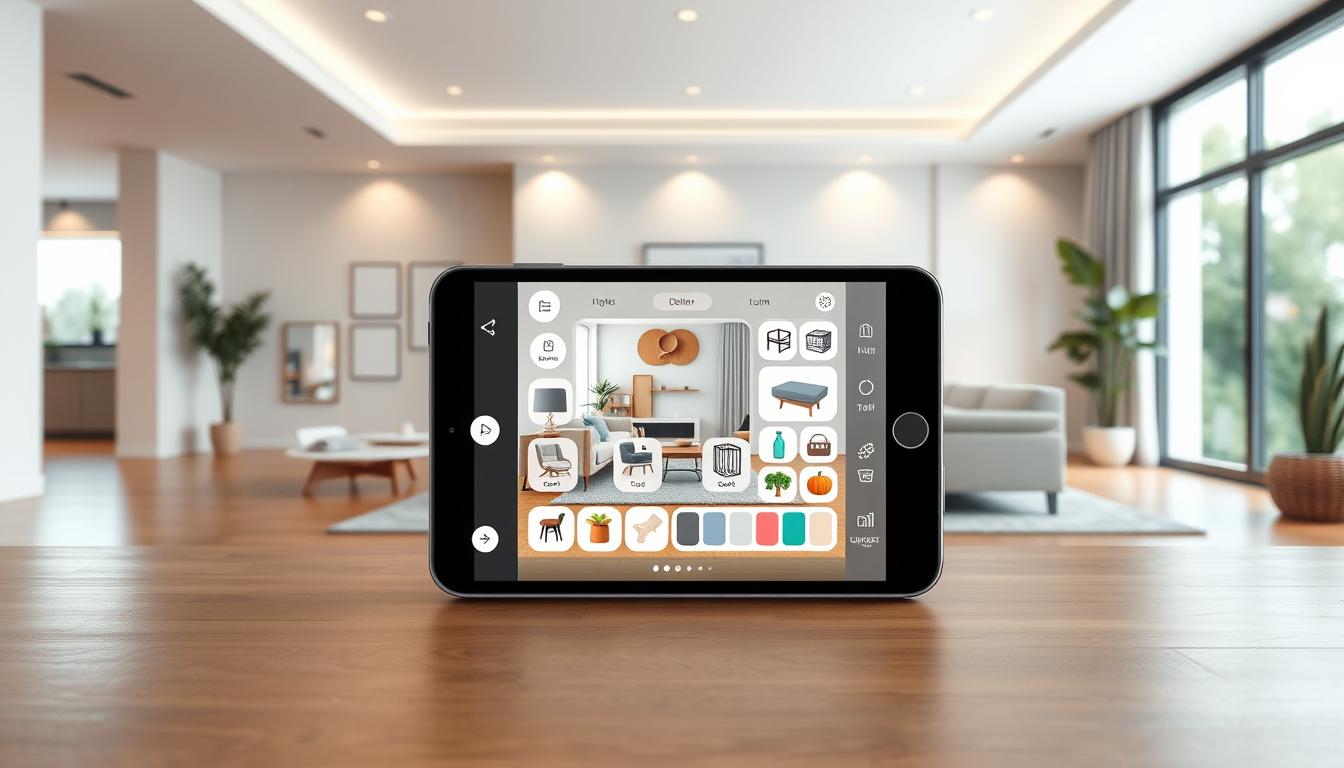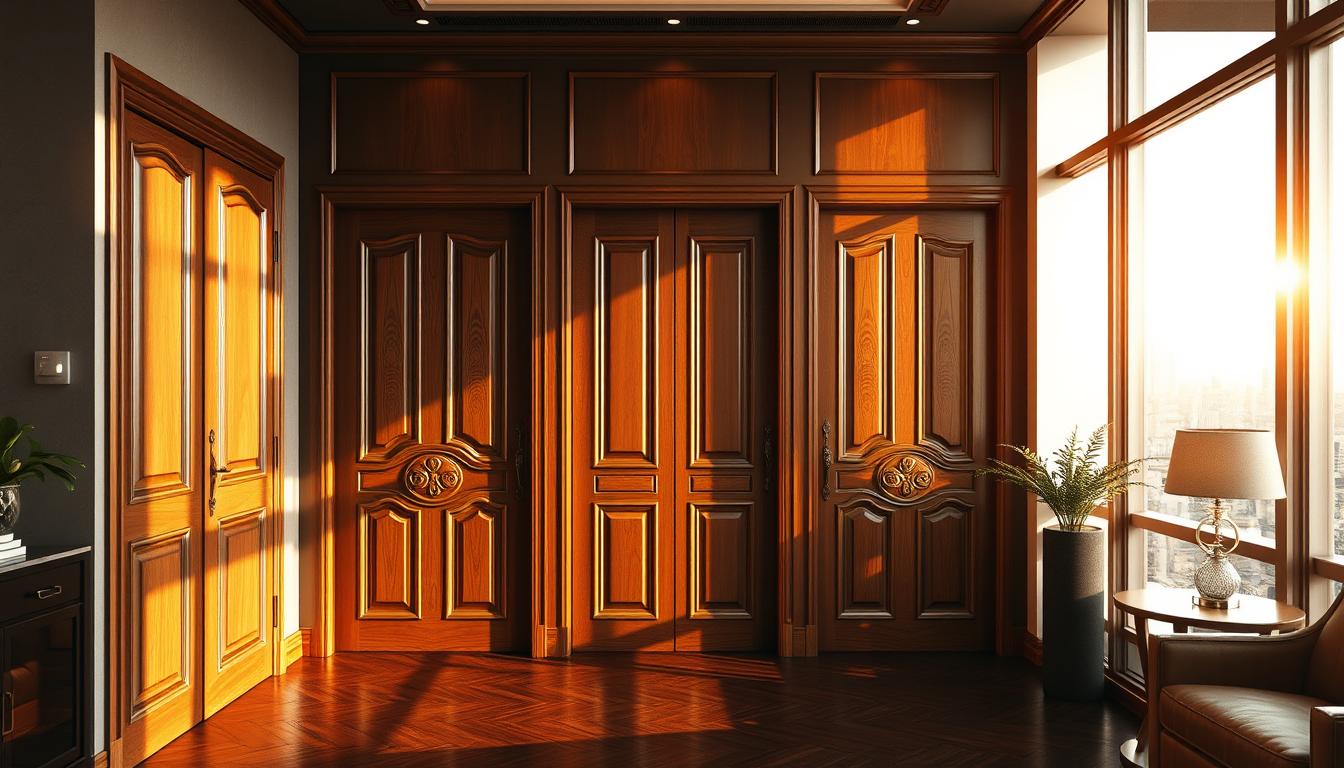Did you know the right interior design style can change your living space? With many styles to pick from, choosing the right one can be hard. Exploring home interior design styles helps us make our homes reflect our personalities and tastes.
Knowing what each style is about helps us elevate our homes with beauty and function. This article will look at various styles, their key features, and how to add them to our homes.
Key Takeaways
- Understanding different home interior design styles
- Characteristics of popular interior design styles
- Tips for incorporating styles into your home
- How to elevate your home with interior design ideas
- Making informed decisions for your living space
Understanding Home Interior Design Styles
There are many interior design styles to pick from. Knowing what each style is about helps us make better choices. We’ll learn how to mix beauty and usefulness in our homes.
Interior design is more than just looks. It’s about making spaces that improve our lives. The style we pick shows who we are, what we like, and how we live.
Definition of Interior Design
Interior design is the art and science of understanding human behavior. It aims to create spaces that are not just pretty but also useful and safe. It’s about knowing what people need and want.
The design process has many steps, from first meeting to putting in the final touches. It needs creativity, technical skills, and knowledge of materials and tech.
| Stage | Description |
|---|---|
| Initial Consultation | Understanding the client’s needs and preferences. |
| Design Development | Creating a detailed design plan based on the client’s input. |
| Installation | Implementing the design plan, including fixtures and furniture. |
Importance of Style in Home Design
The style of our home shows our personality and taste. It turns a house into a home. Choosing the right style greatly affects how we feel about our space.
Styles fit different lifestyles and tastes. For example, modern style fits those who like simplicity, while traditional style suits those who love classic looks.
Knowing the role of style in home design helps us decorate wisely. It’s not just about following trends. It’s about creating a space that feels personal and inviting.
Traditional Interior Design
Traditional interior design is a timeless and elegant style. It brings warmth and sophistication to any home. This classic approach focuses on history and comfort.
Classic Elements
The traditional style includes dark wood tones, intricate patterns, and luxurious fabrics. These elements create a warm and inviting atmosphere. It feels both classic and sophisticated.
Popular Color Schemes
Traditional interior design often uses warm neutrals, deep reds, and rich golds. These colors make the space cozy and opulent. They are key to the traditional design feel.
Common color combinations include rich wood tones with deep, bold colors. Or, warm neutrals with subtle patterns.
Influential Designers
Famous designers like Martha Stewart and Joanna Gaines have made traditional design popular. They show how to mix traditional elements with modern homes. This creates a timeless and elegant look.
Embracing traditional interior design makes spaces feel classic and sophisticated. It’s perfect for those who love a traditional aesthetic.
Modern Interior Design
Modern interior design aims to create open, airy spaces. These spaces are both stylish and functional. It focuses on simplicity, clean lines, and functionality.
Key Features of Modern Design
Modern design has several key features.
- Open Spaces: Getting rid of unnecessary walls and partitions.
- Minimal Ornamentation: Using clean lines and little decor.
- Emphasis on Horizontal and Vertical Lines: Achieving balance.
Use of Materials
Modern interior design uses various materials for both looks and function.
- Sleek Metals: Known for their modern appearance.
- Natural Woods: Bringing warmth.
- Glass: Making spaces feel open.
Furniture Selection
Furniture in modern design is both useful and simple.
- Comfort: Making sure furniture is comfy.
- Sustainability: Picking materials that are good for the planet.
- Minimalism: Choosing furniture with clean lines.
Contemporary Interior Design
Contemporary interior design blends elements from many styles. It’s not just about looks; it shows who lives there. It makes a space personal and unique.
Distinctions from Modern Style
Many think contemporary and modern are the same. But they’re not. Modern design comes from the early 20th century. Contemporary design is about now, using today’s trends and tech.
For those wanting to update, modern interior design concepts are great for inspiration.
Emphasis on Minimalism
Minimalism is key in contemporary design. It uses simple shapes and colors for openness. It’s not just about less stuff; it’s about calm and peace.
Minimalist design often uses neutral colors like whites and grays. This lets statement pieces stand out.
Color and Texture Choices
Even with a neutral base, contemporary design adds colors and textures. Texture is important, mixing materials like wood and glass for beauty.
| Material | Common Use | Aesthetic Contribution |
|---|---|---|
| Wood | Furniture, flooring | Warmth, natural beauty |
| Metal | Lighting, decorative accents | Modernity, sleekness |
| Glass | Tables, decorative elements | Elegance, transparency |
By mixing textures, contemporary design makes spaces lively and beautiful. It’s a flexible way to make homes stylish and useful.
Industrial Interior Design
Industrial interior design celebrates the beauty of unfinished materials. It draws inspiration from old factories and industrial spaces. This style is popular for its unique mix of ruggedness and modernity.
Defining Industrial Aesthetics
Industrial design is inspired by old factories. It features exposed brick, metal beams, and reclaimed wood. These elements give the style a raw, unfinished look.
The use of materials like concrete, steel, and vintage machinery adds to the industrial feel. It makes the space feel both modern and historically rich.
Key Materials and Textures
The industrial style loves raw, unfinished materials. Common materials include:
- Reclaimed wood for its warmth and history
- Exposed brick for a rugged touch
- Metal beams and accents for solidity and strength
- Concrete for its durability and minimalist look
These materials, left in their raw state, add authenticity and character to the industrial look.
| Material | Characteristics | Uses in Industrial Design |
|---|---|---|
| Reclaimed Wood | Warmth, historical significance | Furniture, flooring, wall accents |
| Exposed Brick | Ruggedness, texture | Feature walls, decorative elements |
| Metal Beams | Solidity, strength | Structural elements, decorative accents |
Lighting Choices
Lighting in industrial design often has metal shades, pendant lights, and exposed bulbs. These choices add to the rugged, utilitarian look. They provide light and decorate the space.
Choosing the right lighting can highlight the unique character of a space. It makes the industrial style stand out.
Farmhouse Interior Design
Farmhouse interior design mixes old charm with today’s comfort. It’s great for those who want a cozy home.
Elements of Farmhouse Style
Farmhouse design uses reclaimed wood and old decor. These add history and warmth.
Classic patterns like stripes and florals make it cozy. Natural materials like wood and stone add to the rustic look.
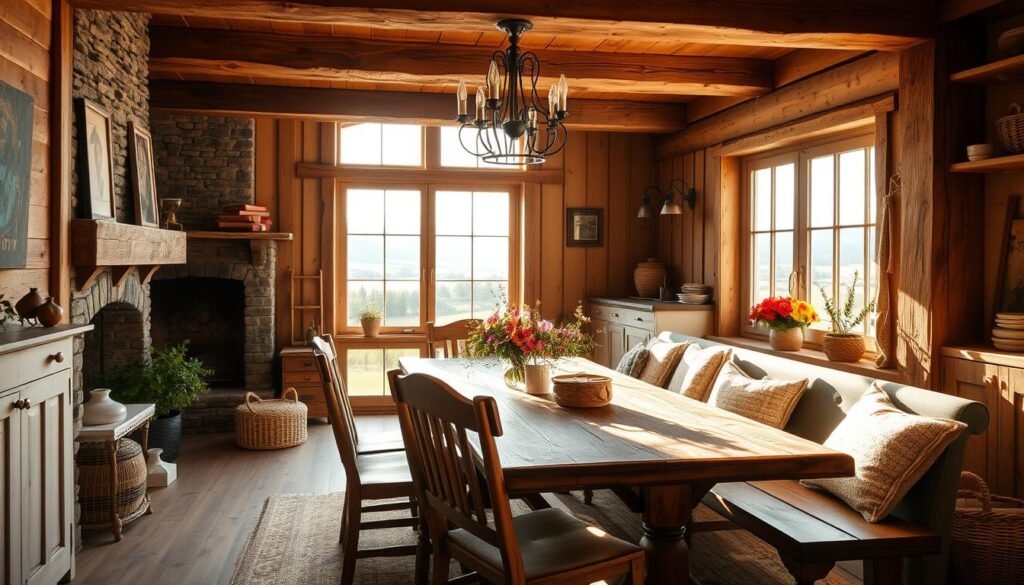
Color Schemes and Textures
Farmhouse design often uses soft neutrals, warm whites, and muted pastels. These colors are calming and welcoming.
Textures are key, with smooth, rough, and soft materials. This mix adds depth and interest.
Popular Furniture Types
Farmhouse design loves vintage finds, rustic benches, and comfortable sofas. These pieces are chosen for their comfort and character.
Vintage furniture makes the space unique and personal. Comfortable sofas and chairs ensure it’s both beautiful and functional.
By using these elements, we can make a home that feels like a cozy retreat. Farmhouse design is about simplicity and warmth, appealing to many.
Bohemian Interior Design
Bohemian interior design is all about being bold and unique. It’s great for those who love mixing different patterns, colors, and textures. This style helps you create a space that truly reflects you.
Embracing Eclectic Styles
Bohemian design is all about being eclectic. It’s about combining pieces from different cultures, eras, and styles. Layering different textiles, like vintage rugs and colorful tapestries, adds depth and interest.
Use of Patterns and Colors
Bohemian design is known for its bold patterns and colors. Rich jewel tones, earthy naturals, and brights are common. Mixing patterns like paisley and florals makes a room lively. The trick is to mix them in a way that feels right for you.
Accessorizing Bohemian Spaces
Accessories are key in bohemian design. Vintage items and unique pieces add to the eclectic vibe. Adding plants and macrame wall hangings can also enhance the bohemian feel.
| Element | Description | Example |
|---|---|---|
| Textiles | Layering different fabrics and textures | Vintage rugs, colorful tapestries |
| Patterns and Colors | Mixing bold patterns and vibrant colors | Paisley, florals, jewel tones |
| Accessories | Adding unique and global decorative pieces | Vintage items, macrame wall hangings |
Mid-Century Modern Interior Design
Mid-century modern interior design is all about simplicity and blending with nature. It emerged in the mid-20th century. This style focuses on functionality, clean lines, and organic shapes.
Key Characteristics
Mid-century modern design is known for a few key things. It uses a limited color palette and natural materials. It also has large windows to let in natural light.
Key Features of Mid-Century Modern Design:
- Clean lines and minimal ornamentation
- Organic shapes and geometric forms
- Integration with nature through large windows and outdoor spaces
- Emphasis on natural materials such as wood and leather
- Limited color palette with an emphasis on earth tones
Iconic Furniture
Mid-century modern design is famous for its iconic furniture. Designers like Charles and Ray Eames, and Isamu Noguchi made pieces that were both beautiful and functional.
| Furniture Piece | Designer | Description |
|---|---|---|
| Eames Lounge Chair | Charles and Ray Eames | A molded plywood and leather chair known for its comfort and style |
| Noguchi Coffee Table | Isamu Noguchi | A sculptural coffee table made from glass and wood |
| Tulip Table | Eero Saarinen | A dining table with a cast aluminum base and a round or oval top |
Bringing in Nature
Mid-century modern design loves to bring nature inside. It uses big windows, sliding glass doors, and outdoor spaces. This makes the indoors feel like outdoors.
“The more you know, the more you realize that the most successful designs are those that seamlessly blend the indoors with the outdoors.”
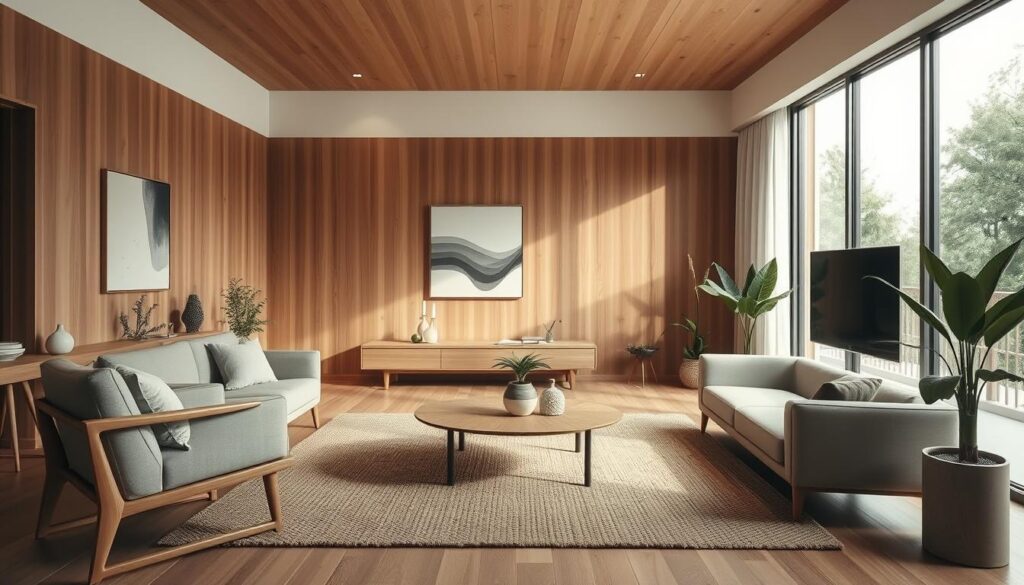
Mid-century modern design combines retro and contemporary styles. It creates homes that are beautiful and connected to nature. As we draw inspiration from this style, we can make homes that are both stunning and natural.
Eclectic Interior Design
Eclectic interior design is all about mixing different styles to make a space truly unique. It lets us show off our personality by combining elements that reflect our tastes and experiences.
Blending Diverse Styles
At the core of eclectic design is blending various styles. We can pair modern furniture with vintage items, or mix industrial with luxurious textures. This creates a space that’s both interesting and personal.
To blend styles well, consider these tips:
- Balance contrasting elements to avoid visual overload.
- Use a unifying color scheme to tie different pieces together.
- Select a few statement pieces and keep the rest of the decor more subdued.
The Importance of Personal Touch
Eclectic design is not just about mixing styles. It’s also about adding personal touches that make a space feel truly ours. This can include family heirlooms, travel souvenirs, or personal art collections.
By adding personal items, we give our living spaces layers of meaning. This makes them more inviting and shows off our personalities.
Tips for Achieving Balance
Balance is key in eclectic design. Here are some tips to help achieve it:
- Start with a neutral base and add bold, eclectic pieces.
- Experiment with different textures and colors to add depth.
- Don’t be afraid to edit your space regularly to maintain harmony.
| Design Element | Eclectic Style Tip | Benefit |
|---|---|---|
| Color Scheme | Use a unifying color to tie different pieces together. | Creates harmony |
| Furniture | Mix modern with vintage or antique pieces. | Adds character |
| Textures | Combine different materials like wood, metal, and fabric. | Enhances visual interest |
By embracing eclectic interior design, we can create spaces that are unique, visually appealing, and deeply personal. These spaces reflect our individual styles.
Choosing the Right Style for Your Home
Choosing the right home interior design style is a thoughtful process. We need to think about our lifestyle, personal tastes, and our home’s architecture. This helps us create a space that looks great and works well.
Assessing Our Space
First, we should assess our space and its unique features. We need to look at the size, layout, and natural light in our home.
Finding Inspiration
We can find inspiration in many places, like design magazines, social media, and showrooms. Gathering ideas helps us see the perfect style for our home.
Making Decisions
When making design choices, we must balance what we want with what’s practical. This way, our chosen style is both beautiful and functional. Exploring different styles helps us create a home that shows our personality and meets our needs.

